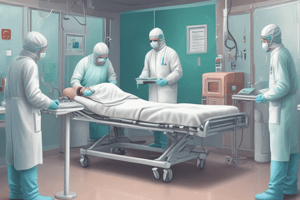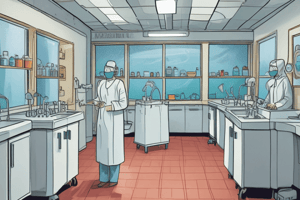Podcast
Questions and Answers
What is one of the primary risks patients face in healthcare settings?
What is one of the primary risks patients face in healthcare settings?
- Overexposure to clean air
- Increased access to nutritional supplements
- Resistance to common antibiotics (correct)
- Lower access to medical personnel
Which infection prevention measure is crucial for healthcare workers?
Which infection prevention measure is crucial for healthcare workers?
- Frequent hand washing only
- A healthy diet
- Constant supervision by a physician
- Knowledge of the infectious process (correct)
What is a common characteristic of patients in healthcare settings?
What is a common characteristic of patients in healthcare settings?
- They generally avoid any invasive procedures.
- They are less exposed to disease-causing microorganisms.
- They often have lower resistance to infectious microorganisms. (correct)
- They have higher resistance to infections.
What is one purpose of infection control in healthcare?
What is one purpose of infection control in healthcare?
Which disease requires heightened infection control measures due to its severe consequences?
Which disease requires heightened infection control measures due to its severe consequences?
Which practice should be included in patient teaching regarding infection prevention?
Which practice should be included in patient teaching regarding infection prevention?
How can nurses help prevent the spread of infection?
How can nurses help prevent the spread of infection?
Why is it important for patients to understand modes of transmission?
Why is it important for patients to understand modes of transmission?
What is NOT a reason for increased emphasis on infection-control techniques?
What is NOT a reason for increased emphasis on infection-control techniques?
In what type of healthcare settings are patients most likely to face the risk of infections?
In what type of healthcare settings are patients most likely to face the risk of infections?
Which microorganisms are classified as pathogens?
Which microorganisms are classified as pathogens?
What happens when resident skin microorganisms enter deep tissues during an invasive procedure?
What happens when resident skin microorganisms enter deep tissues during an invasive procedure?
What is the correct order of elements in the chain of infection?
What is the correct order of elements in the chain of infection?
Which statement correctly describes a communicable disease?
Which statement correctly describes a communicable disease?
What is considered a portal of exit in the chain of infection?
What is considered a portal of exit in the chain of infection?
What effect does an impaired immune system have on susceptibility to infections?
What effect does an impaired immune system have on susceptibility to infections?
What can break the chain of infection according to infection control practices?
What can break the chain of infection according to infection control practices?
What type of disease is caused specifically by pathogens that are capable of transmission?
What type of disease is caused specifically by pathogens that are capable of transmission?
Which of the following best describes nonpathogens?
Which of the following best describes nonpathogens?
Which option describes a characteristic of infections caused by pathogens?
Which option describes a characteristic of infections caused by pathogens?
Flashcards are hidden until you start studying
Study Notes
Importance of a Safe Environment for Health
- Safe environments significantly contribute to good health by controlling the transmission of infections.
- Patients in healthcare settings are at higher risk for infections due to lower resistance and increased exposure to pathogens.
- Invasive procedures elevate the risk of infection as they enter body cavities or organs.
Risks and Protection in Healthcare Settings
- Acute care and ambulatory care facilities present risks from antibiotic-resistant pathogens.
- Infection prevention and control techniques are essential for nurses to protect patients from microorganisms.
- Educating patients and families on recognizing infection sources and implementing protective measures is crucial.
Infection Knowledge for Patients
- Patient education should cover:
- Types of infections
- Modes of transmission
- Prevention methods
Health Care Workers' Safety
- Healthcare workers must understand:
- The infectious process
- Appropriate barrier protections to safeguard against infectious materials.
Increased Focus on Infection Control
- Diseases prompting heightened infection-control focus include hepatitis B and C, AIDS, SARS, TB, Ebola, and COVID-19.
- Infection control aims to:
- Protect patients from infections
- Safeguard healthcare workers
- Shield populations from communicable diseases.
Understanding Microorganisms
- Microorganisms, which include bacteria, protozoa, algae, and fungi, can only be seen under a microscope.
- They inhabit various environments, including air, water, food, soil, plants, animals, and humans.
- Most microorganisms are nonpathogenic but can become pathogenic and cause disease.
Infection Definition and Communicability
- An infection arises from a pathogen entering and multiplying in host tissues, resulting in clinical symptoms.
- Infectious diseases can spread between individuals, deemed communicable diseases.
Chain of Infection Components
- An infection develops through a cycle involving:
- An infectious agent (pathogen)
- A reservoir for pathogen growth
- A portal of exit from the reservoir
- A mode of transmission
- A portal of entry to a new host
- A susceptible host.
- Breaking any part of this chain interrupts the development of infections.
Role of Nurses in Infection Prevention
- Nurses must remain vigilant and adhere to infection prevention and control practices to disrupt the chain of infection effectively.
Studying That Suits You
Use AI to generate personalized quizzes and flashcards to suit your learning preferences.




